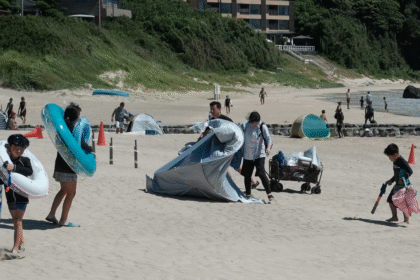Kilauea Volcano Eruption Sends Lava Fountain 1,000 Feet High Over Hawaii
Kilauea Volcano Spews Towering Lava Fountains Over 1,000 Feet in Spectacular Eruption
The Kilauea volcano on Hawaii’s Big Island once again demonstrated its raw volcanic power on Sunday as it erupted in dramatic fashion, sending lava fountains more than 1,000 feet into the air. The United States Geological Survey (USGS) confirmed the explosive activity, which occurred within the Halemaʻumaʻu crater—located at the volcano’s summit—and captivated viewers both on the island and worldwide.
The event marks the 23rd episode of volcanic activity at Kilauea since its most recent eruption cycle began on December 23, 2024. Although intermittent, the volcano’s eruptions continue to display its status as one of the most active in the world.
Eruption Timeline and Intensity
According to the USGS Hawaiian Volcano Observatory, the latest eruption began at approximately 4:15 PM Hawaii Standard Time on Sunday, originating from the north vent of Halemaʻumaʻu. Within an hour, activity was also observed at the south vent, with both vents emitting powerful lava jets.
The USGS reported that while the southern lava fountains reached heights of around 230 feet, the northern fountains exceeded 1,000 feet—roughly equivalent to a 75-story skyscraper. “Lava flows are covering the floor of Halemaʻumaʻu crater,” the agency noted, adding that the vigorous eruption lasted for less than 24 hours, in line with previous recent events.
Volcanic Hazards and Environmental Impact
With the resumption of eruptive activity, residents and visitors near Hawaii Volcanoes National Park have been advised to exercise caution due to the high levels of volcanic gas being released. One of the primary concerns is the formation of “vog,” or volcanic smog, a visible haze created when sulfur dioxide and other volcanic gases react with sunlight, oxygen, and moisture in the atmosphere.
The USGS warned that vog can have health implications for people and animals, especially those with respiratory conditions. Additionally, it can damage crops and reduce visibility for motorists and aircraft. While no immediate evacuations were ordered, the agency continues to monitor the situation and advise local authorities accordingly.
Kilauea’s Eruptive History
Kilauea is one of six active volcanoes in the Hawaiian Islands and is widely considered one of the most active on the planet. Since 1983, it has had frequent eruptions, often drawing tourists eager to witness the dramatic lava flows and fiery displays.
Despite its smaller size compared to neighboring Mauna Loa—the largest volcano in the world—Kilauea is responsible for the majority of Hawaii’s recent volcanic activity. Its persistent eruptions have reshaped parts of the Big Island, influencing the region’s geology, ecosystem, and local economy.
Sunday’s eruption follows a pattern of short-lived but visually intense volcanic activity that has become typical of Kilauea in recent years. Scientists have noted that while such eruptions can be spectacular, they are generally contained within the summit crater and pose limited risk to surrounding communities unless accompanied by seismic activity or lava migration.
Scientific Observations and Monitoring
The USGS maintains a network of seismic, thermal, and gas monitoring stations around Kilauea, allowing real-time assessment of volcanic activity. In the wake of the latest eruption, scientists recorded minor ground deformation and increased seismic tremor, indicators of magma movement beneath the surface.
“Given the history of short-lived summit eruptions over the past year, we are closely watching for any signs of increased activity or lava outflows beyond the caldera,” said a USGS volcanologist.
The observatory has also deployed drones and thermal imaging tools to assess the structural integrity of the crater floor and to track new lava flows. While the current eruption does not appear to be escalating into a larger event, officials are urging caution.
Tourism and Public Safety
The Hawaii Volcanoes National Park remains open, but specific viewing areas near the caldera may be temporarily restricted due to elevated volcanic gas levels and the risk of ashfall. Visitors are encouraged to check for updates from park authorities and the USGS before venturing near active zones.
Local tourism officials noted that interest in visiting the park tends to surge following eruptions, as lava displays attract thousands of curious onlookers. However, they emphasized that safety remains a priority and that guests should adhere to all posted warnings and guidelines.
Conclusion
The latest eruption of Kilauea has once again reminded the world of the powerful geological forces at play beneath Hawaii’s surface. With lava fountains exceeding 1,000 feet and the ever-present risk of vog, the USGS and local authorities continue to monitor conditions closely. As scientists work to understand the evolving patterns of one of Earth’s most active volcanoes, the spectacle serves as both a marvel of nature and a prompt for vigilance in the face of natural hazards.
Also Read : Massive Explosion at Youdao Chemical Plant in China Triggers Emergency Response








